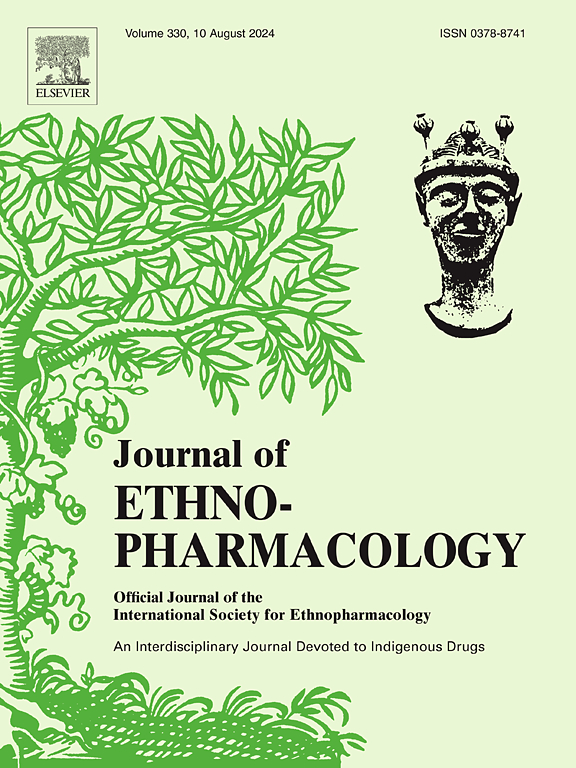白头草汤正丁醇提取物通过调节线粒体相关的I型干扰素信号通路缓解外阴阴道念珠菌病。
IF 4.8
2区 医学
Q1 CHEMISTRY, MEDICINAL
引用次数: 0
摘要
民族药理学相关性:外阴阴道念珠菌病(VVC)是一种相对常见的女性生殖道真菌感染性疾病。VVC的发病机制不仅与白色念珠菌(C. albicans)感染有关,还与阴道黏膜免疫系统对真菌的免疫反应不当有关。白头翁汤作为经典方剂,在临床和实验研究中均被证明对VVC有保护作用。白头草汤治疗VVC的具体机制尚不清楚。本研究从I型干扰素信号通路及相关线粒体功能角度探讨白头翁汤正丁醇提取物(BEPD)治疗VVC的作用机制。材料与方法:采用基于雌激素的方法建立VVC大鼠模型,评价BEPD对VVC的治疗效果,并从真菌形态和负荷、中性粒细胞数量、组织病理学、促炎和抗炎细胞因子产生、LDH水平等方面综合评价BEPD对VVC的治疗效果。采用免疫组化(IHC)、免疫荧光(IF)、Western Blot (WB)和RT-qPCR检测ⅰ型干扰素信号传导和线粒体功能。以体外假丝酵素诱导的阴道上皮炎症为细胞模型,检测含bepd血清干预前后I型干扰素信号和线粒体功能的变化。结果:BEPD能显著改善VVC模型大鼠的炎症反应,减轻真菌负荷,抑制真菌生长,平衡促炎和抗炎细胞因子水平。IHC、IF、WB和RT-qPCR结果显示,BEPD能促进VVC模型大鼠I型干扰素信号传导,减轻线粒体功能损伤,体外实验中含BEPD血清也能起到同样的作用。结论:研究结果普遍表明,BEPD可通过调节I型干扰素信号和线粒体功能,改善VVC炎症,纠正免疫失衡。本文章由计算机程序翻译,如有差异,请以英文原文为准。

n-butanol extract of Pulsatilla decoction alleviates vulvovaginal candidiasis via the regulation of mitochondria-associated Type I interferon signaling pathways
Ethnopharmacological relevance
Vulvovaginal candidiasis (VVC) is a relatively common fungal infectious disease in the female reproductive tract. The pathogenesis of VVC not only involves Candida albicans (C. albicans) infection, but also the improper immune response of the vaginal mucosal immune system to the fungus. As a classical formula, Pulsatilla decoction has been proven to exert protective effect in both clinical and experimental research in VVC. However, the specific mechanism of Pulsatilla decoction in VVC remains elusive. This study investigated the mechanism of n-butanol extract of Pulsatilla decoction (BEPD) in treating VVC from the perspective of type I interferon signaling and related mitochondrial function.
Materials and methods
A VVC-rat model was developed using an estrogen-based method to evaluate the effectiveness of BEPD in treating VVC, and the therapeutic efficacy of BEPD against VVC was comprehensively evaluated by fungal morphology and burden, neutrophil numbers, histopathology, pro-inflammatory and anti-inflammatory cytokines production, and LDH level. Immunohistochemistry (IHC), immune fluorescence (IF), Western Blot (WB) and RT-qPCR assays were conducted to assess type I interferon signaling and mitochondria functions. Candidalysin-induced vaginal epithelial inflammation in vitro, as cellular models, was employed to detect the changes in type I interferon signaling and mitochondria function before and after BEPD-containing serum intervention.
Results
BEPD could significantly improve the inflammation, reduce fungal loads and inhibit fungal growth, balance pro-inflammatory and anti-inflammatory cytokine levels in VVC model rats. The findings from IHC, IF, WB and RT-qPCR revealed that BEPD could promote type I interferon signaling and alleviate mitochondrial functional damage in VVC model rats, and BEPD-containing serum could play the same role in vitro.
Conclusion
The study findings generally demonstrated that BEPD could improve the inflammation and correct the immune imbalance in VVC through regulation of type I interferon signaling and mitochondrial function.
求助全文
通过发布文献求助,成功后即可免费获取论文全文。
去求助
来源期刊

Journal of ethnopharmacology
医学-全科医学与补充医学
CiteScore
10.30
自引率
5.60%
发文量
967
审稿时长
77 days
期刊介绍:
The Journal of Ethnopharmacology is dedicated to the exchange of information and understandings about people''s use of plants, fungi, animals, microorganisms and minerals and their biological and pharmacological effects based on the principles established through international conventions. Early people confronted with illness and disease, discovered a wealth of useful therapeutic agents in the plant and animal kingdoms. The empirical knowledge of these medicinal substances and their toxic potential was passed on by oral tradition and sometimes recorded in herbals and other texts on materia medica. Many valuable drugs of today (e.g., atropine, ephedrine, tubocurarine, digoxin, reserpine) came into use through the study of indigenous remedies. Chemists continue to use plant-derived drugs (e.g., morphine, taxol, physostigmine, quinidine, emetine) as prototypes in their attempts to develop more effective and less toxic medicinals.
 求助内容:
求助内容: 应助结果提醒方式:
应助结果提醒方式:


